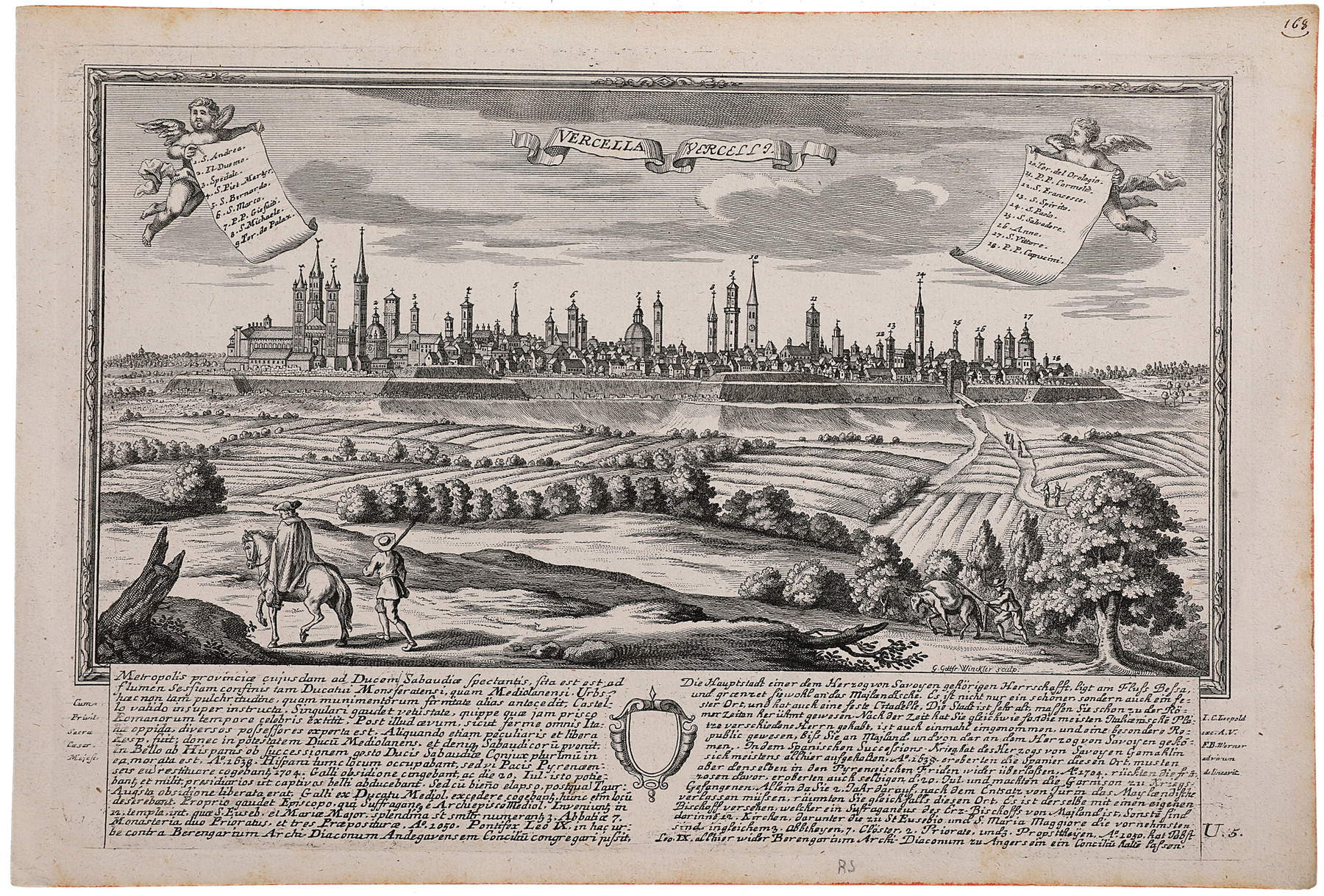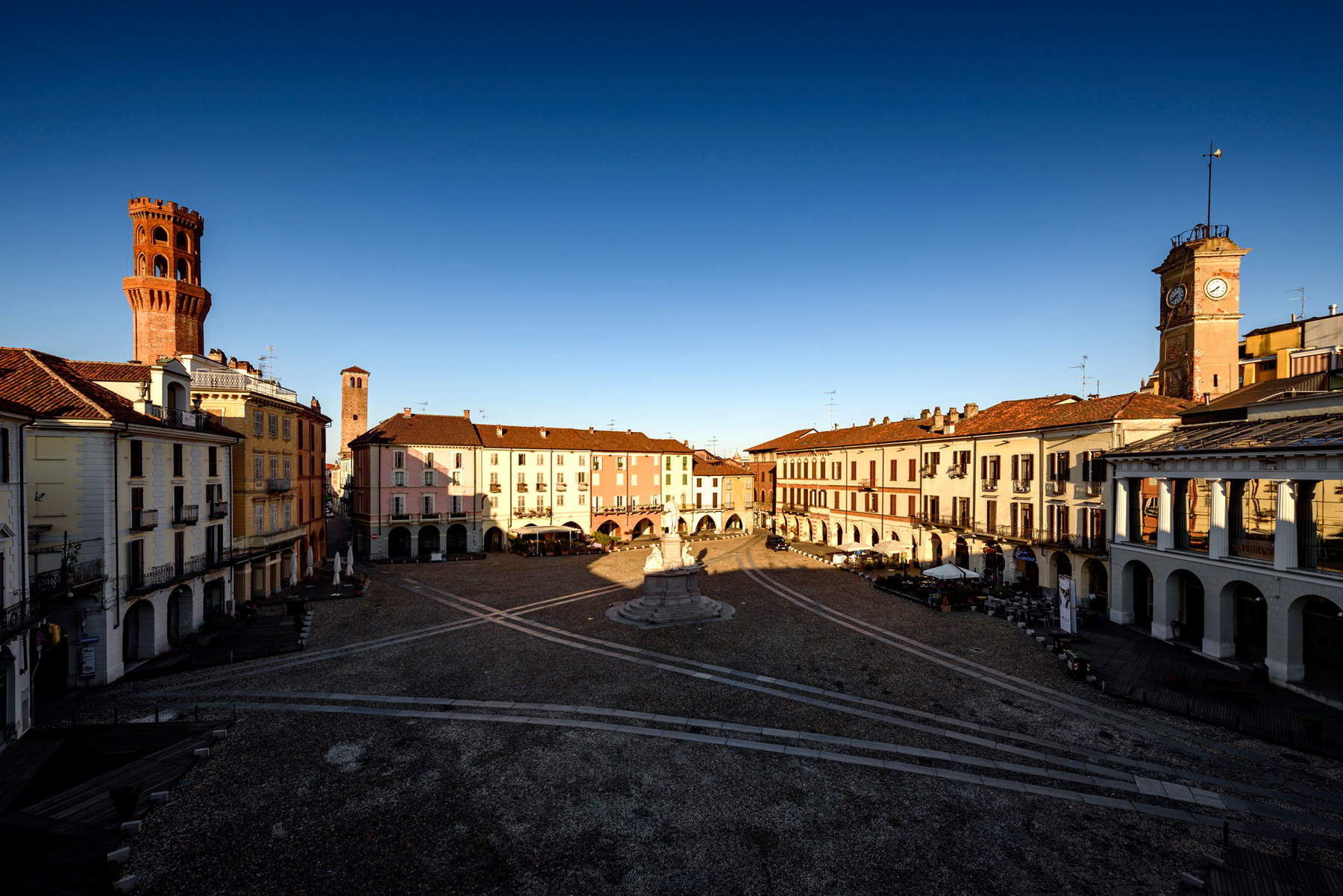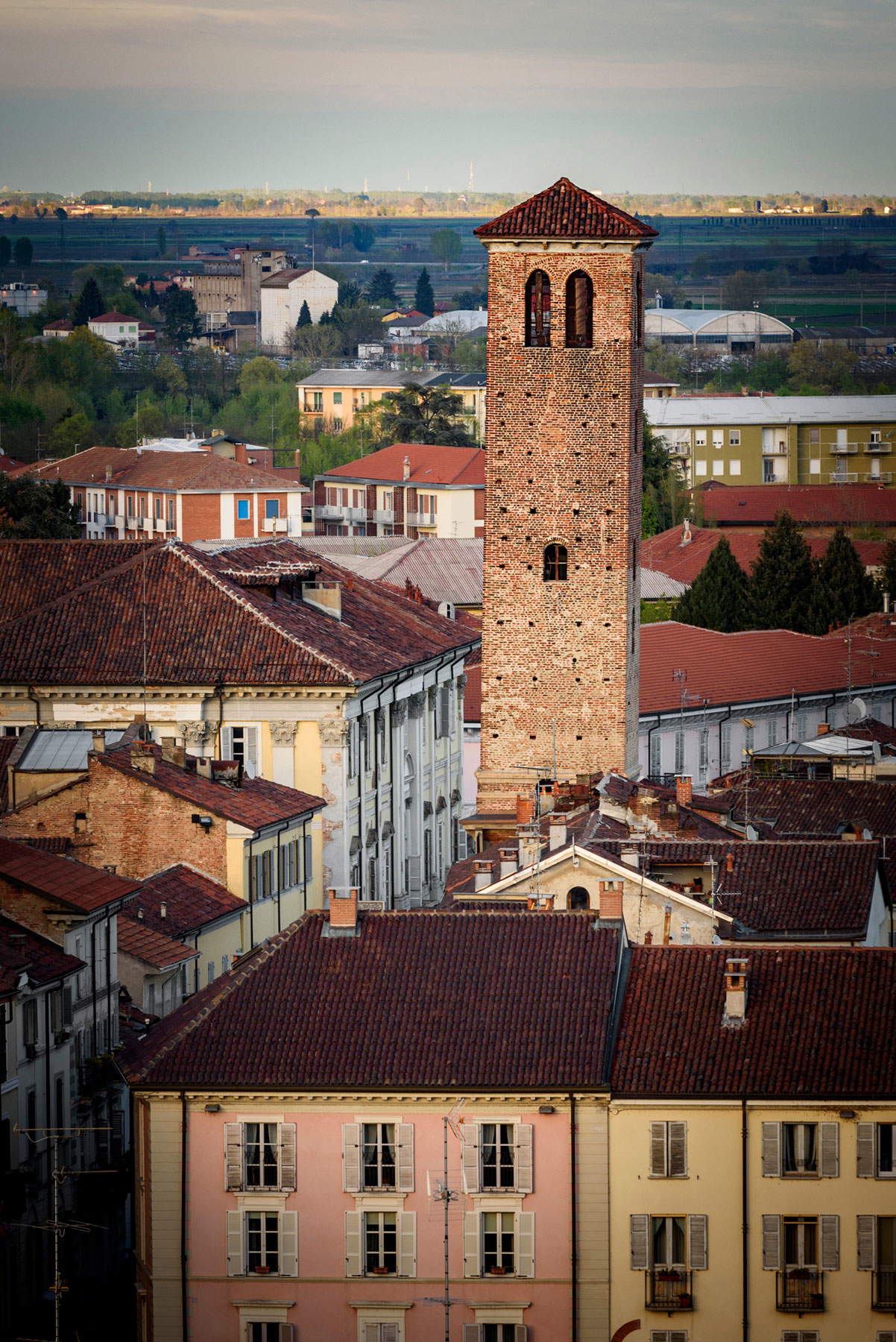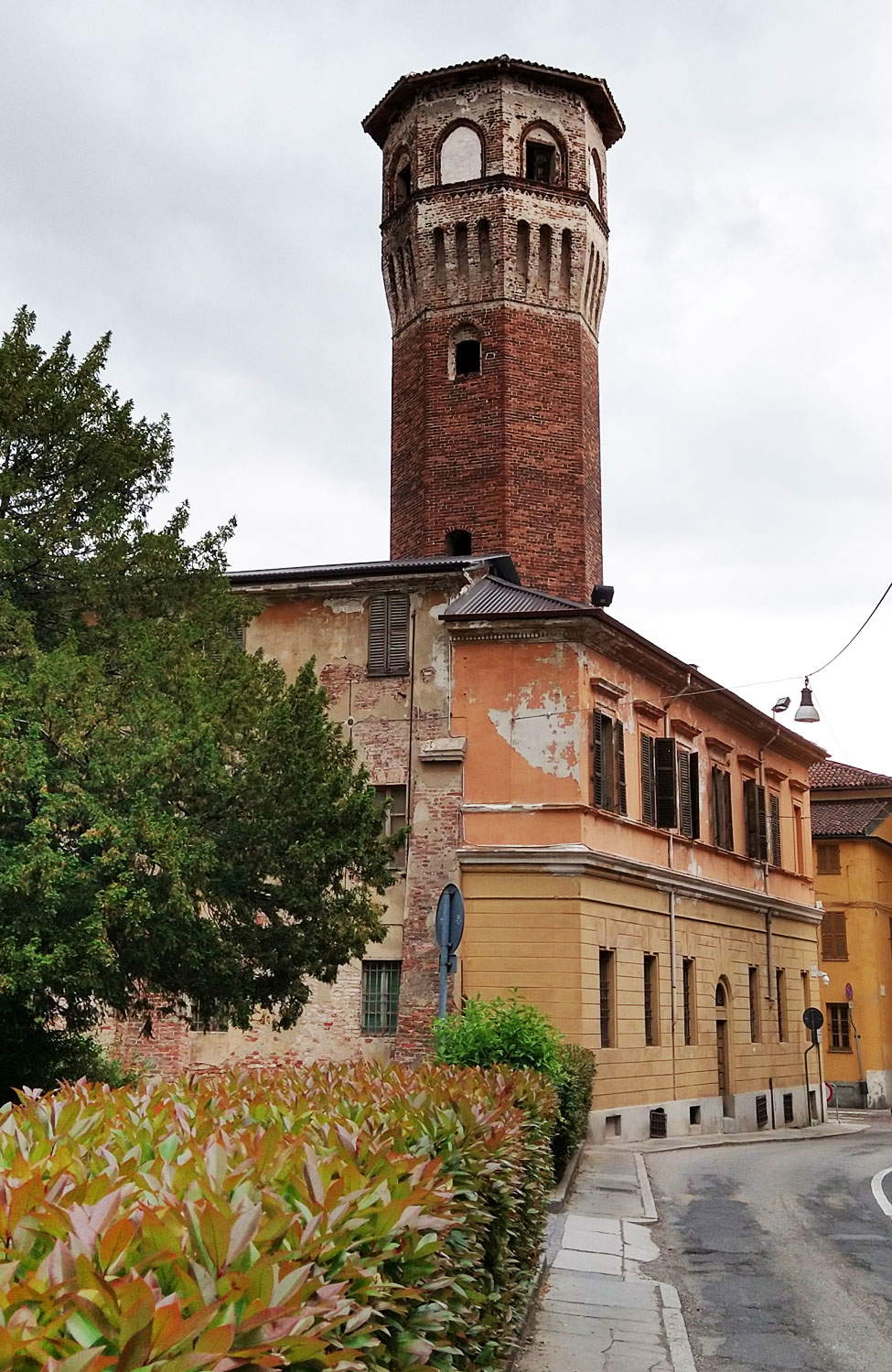As illustrated in theengraving depicting a view of Vercelli as a turreted city, in medieval times the city on the Sesia River was full of towers. A skyline that had nothing to envy San Gimignano. The engraving, published in Augsburg between 1730 and 1745, belongs to a series of views of European turreted cities sold separately. Kept at the Agnesiana Diocesan Library in Vercelli, the print shows the title Vercella-Vercelli on a ribbon at the top, towering over the verdant landscape with the walled city in the background and a numerous presence of towers; on either side of the ribbon are two cartouches, each supported by a winged putto and on which are written the eighteen names of bell towers and towers dating from the Middle Ages. These include Sant’Andrea, the Duomo, Spedale, San Marco, Torre da Palazzo, Torre dell’Orologio, Santo Spirito, and so on. Thus, the profile of Vercelli as it looked around 1730, when the remains of the ramparts dismantled by the French in 1704 were still present, and especially when many towers still towered over the city, dominating it from above, is illustrated here.
The towers were in fact symbols of power that the most prestigious families had built to highlight their relevant role in society; even today, walking around Vercelli and looking up to the sky, one can admire several of them, evidence of their most flourishing era, but of the most important only five have been preserved: the Tizzoni Tower, the Vialardi Tower, the Angel Tower, the City or Municipal Tower and the Tower of San Marco. Their names refer to the relative families they represented or to particularly significant places in the city.
 |
| Vercelli Turrita (Augusta, 1730-1745; engraving, 330 x 225 mm; Vercelli, Agnesiana Diocesan Library) |
 |
| Vercelli, Piazza Cavour with the towers |
 |
| Vercelli, Piazza Cavour at night. Photo Finestre Sull’Arte |
 |
| The bell towers of the basilica of St. Andrew. |
The best known is the Angel Tower that stands out on the centrally located Piazza Cavour. According to popular legend, it seems that its name derives from themiraculous intervention of an angel who allegedly saved the life of a man passing through Vercelli who, having climbed the tower to enjoy the panoramic view of the city, leaned too far and fell. During the fall, the man invoked the Virgin, to whom he was very devoted, at which point an angel appeared and grabbed him, bringing him safely to the ground. Other literary sources speak of a miraculous intervention by St. Maurus toward a man who fell from the tower in 543, but this would not explain the name given to the tower.
Built in the 14th century, it has a square base on which a late Gothic octagonal body is inserted, ending in long medieval machicolations. The elevation with large windows and crenellated top, on the other hand, dates from 1875 and was interpreted in neo-Gothic style by surveyor Angelo Bosso. A 15th-century terracotta decoration, still present in the courtyards over which the tower dominates, adorns the intrados of the arches; the masonry outcropping from the ground and the basement are probably Romanesque, while the remaining architectural elements date from the late 14th and early 15th centuries. Very striking and typical is the view from the opposite arcades, particularly through the very narrow ninth archway, called the “lancet.”
 |
| Angel Tower |
The oldest and tallest (37 meters) among the noble towers of Vercelli is the Torre di Città or Municipal Tower. With a quadrangular plan and more unadorned than the others, it was a reference point for all the people of Vercelli, who regulated their lives on its bells and large clock (from the end of the 14th century). For many centuries it dominated the town hall. The bells rang to summon the city parliament and the people, to announce a time of celebration or mourning, or to signal imminent danger. In the seventeenth century there were three bells, but after the French-Spanish siege of 1704, of which they still preserve the marks of cannon shots, it proved necessary to surrender one of them to pay the impositions of the victors: there remained a “big bell” and a smaller bell that was later donated to the church of Billiemme so that with its tolling it would remember those who had fallen for their country.
It is not known who built the tower, even the oldest sources do not remember; however, it is still visible today both from Via Gioberti and from “Piazza dei Pesci” or Piazza Palazzo Vecchio, so called because it overlooked the site of theold Broletto, where the old offices of the municipality were located. The structure is almost entirely covered with beige plaster and the remaining portion covered with brick; there are then round-arched windows arranged in an irregular order, and the upper part shows two such windows on each facade. Holes left by workers for possible restoration can be seen on the wall surface. In 1821 lightning knocked down the spire, which, according to sources, was octagonal and very tall, about twenty meters.
 |
| Civic Tower |
Located alongside Corso Libertà, toward Porta Milano, the Tizzoni Tower is part of the palace, datable to the mid-15th century, of the Ghibelline Tizzoni family. This is a family of very ancient origins: probably descended from a military tribune killed during the Battle of Ravenna. In the 12th century a nephew of the latter had become mayor of Vercelli, and all his relatives distinguished themselves in the fields of science and letters. Always Ghibellines and enemies of another important family, the Avogadros, the Tizzoni family had among their most prominent exponents Pietro Tizzoni, a young Ghibelline in the 16th century who as a warrior defeated the Guelphs led by the Avogadros in a battle at Trino in March 1329, during which the village not far from Vercelli was occupied and burned. After this battle, Riccardo Tizzoni, leader of the Ghibellines of Vercelli who was appointed imperial vicar, distinguished himself. There was no further news of the family since 1334, when the Avogadros won against the Tizzoni, and from that time they disappeared from the political scene.
Pietro Tizzoni is also the protagonist of anancient legend: he, having fallen in love with Maria Avogadro, had her locked up in the tower of his mansion; she, known for her works of charity, resisted the flattery of the man who offered her his wealth in exchange for her favors: this fact contributed to peace between the two families and, with her faith, Maria made Pietro repent of his attitudes. For this reason, the Tower of the Tizzoni is also known as the Tower of the Good Daughter.
Octagonal in shape with morphological motifs similar to those of the Tower of the Angel, the tower underwent restoration and reconstruction in the late 19th century, and in particular those carried out in 1874 to the design of the architect Locarni modified its original appearance: it was plastered, three windows were opened in the lower part, the roof and the mullioned windows below were redone; until 1935 it was completely in terracotta, while more recently the lower part has been covered in stone. Inside, in the ground-floor hall, frescoes on the ribbed vault depicting classical deities by Moncalvo, a well-known artist of the 16th-century Vercelli school, are visible.
 |
| Tizzoni Tower. Photo Finestre Sull’Arte |
Between Via Giovanni Achille Cagna and Via Francesco Antonio Vallotti, on the other hand, is the more slender tower of the Vialardi family, the only surviving almost unaltered dwelling of the noble family of the same name. Of Manfredinga lineage, that is, of Germanic origin and derived from the Lords of Casalvolone, the Vialardi are among the oldest families in Vercelli, already of considerable importance in the 12th century, but then flourishing in the mid-16th century. Among the most significant exponents were the nobleman Manfredo Vialardi, whose ancestors were feudal lords of Verrone (the Vialardi of Verrone were the first lords of the Biellese to pay tribute of allegiance to the Savoy family) invested by the bishop of Vercelli, and Giacomo Vialardi known as Carnario, who became bishop of the city from 1235 to 1241. In later times there were Romualdo Vialardi, duke of Monferrato in 1655, Giovanni who became ducal senator of Mantua, and Carlo Antonio who became governor of the Piazzaforte of Casale in 1678. From the 18th century the family no longer appears in official documents: it lost its political power with the arrival of the Visconti family.
In the 12th century the Vialardi family lived in a house-fortress with a patrician tower in today’s Via del Duomo, built on ancient Roman baths; in 1203 the Credenza Council bought this house-fortress to turn it into the Palazzo del Comune, and the family then had to move to today’s Via Vallotti, where, in the early 15th century, they built the tower that still exists. Also octagonal in shape, it has two windows above other buildings at its base. The upper part consists of a first tier of plumbs and a second tier with eight mullioned windows decorated with terracotta friezes, and above a wide-ribbed truss roof. Among the Vercelli towers, it is the one that has best maintained its original appearance. Entering the small courtyard, the arches of the old Renaissance portico are still visible, and higher up one can see the trace of a fresco frieze, datable to the late 15th century, that decorated the room along with other ornaments.
 |
| Vialardi Tower. Photo Finestre Sull’Arte |
The Tower of San Marco, erected from August 19, 1266, when the foundation stone of the church of the same name was laid, probably belonged to the Avogadro family mansion. Located on Verdi Street, its structure is different from the city’s other towers because of the stringcourse cornice, three-quarters of the way up, and because of the corners, which are blunted by the projection of a pilaster. Although it has an octagonal plan, like the other main aristocratic towers, it can be dated to an earlier period than the latter, but appears instead to be later than the quadrangular City Tower.
The Avogadros were of Manfredingan lineage, and the family name derives from their hereditary position as lawyers and viscounts of the Vercelli church. On the Guelph side, it was defeated by the Tizzoni family, on the Ghibelline side, at the Battle of Trino in 1329, and as a result of this defeat had to go into exile and shut themselves up in castles among the mountains of the Biellese. Exponents of the Avogadros occupied the episcopal chair in the twelfth, thirteenth and fourteenth centuries, while between the nineteenth and twentieth centuries various figures distinguished themselves in the military field, such as Alessandro, General of Army and Senator of the Kingdom of Savoy to whom a street was dedicated, or Lieutenant Colonel Amedeo di Valdengo, or Count Gregorio Agostino, captain in the provincial regiment. Also very well known is the physicist Amedeo Avogadro. During 19th-century work, the upright burial of Simone Avogadro da Collobiano, a condottiere and lord of Vercelli, was found intact; the armor and sword are kept in the Royal Armory.
 |
| Avogadro Tower |
The body of the tower is structured in red-brown brick, and each facade has a double row of holes, which were used in the case of restoration (scaffolding supports were inserted into them); the end is relieved by some rectangular windows partly filled with lighter-colored bricks. Today, both the church (until last century used as a covered market) and the tower are municipal property and should soon be put to public use.
Superstates of the heyday of the city of Vercelli, the towers tell stories and ancient legends that linger on through time and still fascinate; evidence of an ancient power and aspect of the city now almost completely lost.
Warning: the translation into English of the original Italian article was created using automatic tools. We undertake to review all articles, but we do not guarantee the total absence of inaccuracies in the translation due to the program. You can find the original by clicking on the ITA button. If you find any mistake,please contact us.